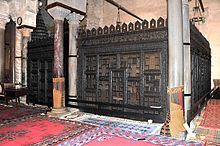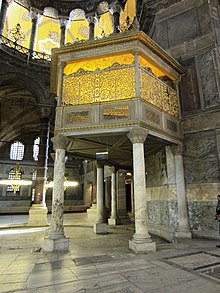Maqsurah

Maqsurah (
There also may have been some spiritual connotation similar to the
History

The first maqsura is believed to have been created by
The oldest maqsura in the Islamic world to be preserved in situ is the wooden maqsura of the Great Mosque of Kairouan, commissioned by the Zirid ruler al-Mu῾izz ibn Badis and dating from the first half of the 11th century (though later restored in the 17th century). It is located directly to the right of the mosque's minbar, and is notable for its woodwork which includes an elaborately carved Kufic inscription dedicated to al-Mu'izz.[5][4] The preserved maqsura of the Great Mosque of Cordoba, although no longer part of a functioning mosque, is even older but represents a very different example. It dates from 965 during Caliph al-Hakam II's expansion of the mosque.[4] Rather than being situated to the side of the mihrab, the maqsura here occupied a rectangular area directly in front of and around the mihrab. Although no physical screen (if there was one) has survived, the area is marked off by the architecture of the arches around it, which differ from the rest of the mosque's arches and present an elaborate interlacing pattern which was highly influential in subsequent Moorish and Moroccan architecture. The area is also covered by three richly-crafted domes above.[4]

Maqsuras continued to be built for some mosques throughout the Islamic world afterwards, though the term also came to denote other kinds of rooms or spaces which do not appear to have been necessarily reserved for the ruler.[4] No clear early examples of maqsuras survive in Iran, but the earliest preserved example appears to be a richly-decorated balcony in the 10th-century Great Mosque of Na'in.[4] The term maqsura is later applied to the domed space in the front of the mihrab in the Great Mosque of Qazvin and maybe also in the Great Mosque of Isfahan (to which Nizam al-Mulk added a large dome in the late 11th century). However, the term here may have had a symbolic architectural meaning rather than a functional meaning, since domes soon became typical of mosque architecture generally.[4]
In
References
- ^ "Maqsurah", Encyclopædia Britannica Online
- ^ Gibbs, H.A.R. The Travels of Ibn Battuta (Munshiram Manoharlal, 1999) p127
- ^ Dictionary of Islamic Architecture Archived 2011-05-25 at the Wayback Machine
- ^ ISBN 9780195309911.
- ^ "Qantara - Maqsûra d'al-Mu'izz". www.qantara-med.org. Retrieved 2020-09-17.

